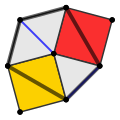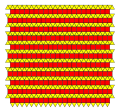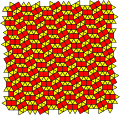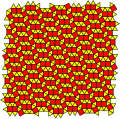Top Qs
Timeline
Chat
Perspective
Snub square tiling
Semiregular tiling of the plane From Wikipedia, the free encyclopedia
Remove ads
In geometry, the snub square tiling is a semiregular tiling of the Euclidean plane. There are three triangles and two squares on each vertex. Its Schläfli symbol is s{4,4}.
| Snub square tiling | |
|---|---|
 | |
| Type | Semiregular tiling |
| Vertex configuration |  3.3.4.3.4 |
| Schläfli symbol | s{4,4} sr{4,4} or |
| Wythoff symbol | | 4 4 2 |
| Coxeter diagram | |
| Symmetry | p4g, [4+,4], (4*2) |
| Rotation symmetry | p4, [4,4]+, (442) |
| Bowers acronym | Snasquat |
| Dual | Cairo pentagonal tiling |
| Properties | Vertex-transitive |
Conway calls it a snub quadrille, constructed by a snub operation applied to a square tiling (quadrille).
There are 3 regular and 8 semiregular tilings in the plane.
Remove ads
Uniform colorings
There are two distinct uniform colorings of a snub square tiling. (Naming the colors by indices around a vertex (3.3.4.3.4): 11212, 11213.)
Circle packing
The snub square tiling can be used as a circle packing, placing equal diameter circles at the center of every point. Every circle is in contact with 5 other circles in the packing (kissing number).[1]
Wythoff construction
The snub square tiling can be constructed as a snub operation from the square tiling, or as an alternate truncation from the truncated square tiling.
An alternate truncation deletes every other vertex, creating a new triangular faces at the removed vertices, and reduces the original faces to half as many sides. In this case starting with a truncated square tiling with 2 octagons and 1 square per vertex, the octagon faces into squares, and the square faces degenerate into edges and 2 new triangles appear at the truncated vertices around the original square.
If the original tiling is made of regular faces the new triangles will be isosceles. Starting with octagons which alternate long and short edge lengths, derived from a regular dodecagon, will produce a snub tiling with perfect equilateral triangle faces.
Example:
 Regular octagons alternately truncated |
→ (Alternatetruncation) |
 Isosceles triangles (Nonuniform tiling) |
 Nonregular octagons alternately truncated |
→ (Alternatetruncation) |
 Equilateral triangles |
Related tilings
Summarize
Perspective
- A snub operator applied twice to the square tiling, while it doesn't have regular faces, is made of square with irregular triangles and pentagons.
- A related isogonal tiling that combines pairs of triangles into rhombi
- A 2-isogonal tiling can be made by combining 2 squares and 3 triangles into heptagons.
- The Cairo pentagonal tiling is dual to the snub square tiling.
Related k-uniform tilings
This tiling is related to the elongated triangular tiling which also has 3 triangles and two squares on a vertex, but in a different order, 3.3.3.4.4. The two vertex figures can be mixed in many k-uniform tilings.[2][3]
Related topological series of polyhedra and tiling
The snub square tiling is third in a series of snub polyhedra and tilings with vertex figure 3.3.4.3.n.
The snub square tiling is third in a series of snub polyhedra and tilings with vertex figure 3.3.n.3.n.
Remove ads
See also
Wikimedia Commons has media related to Uniform tiling 3-3-4-3-4 (snub square tiling).
References
External links
Wikiwand - on
Seamless Wikipedia browsing. On steroids.
Remove ads













































